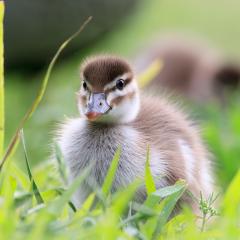 UQ is a haven for our feathered friends, with numerous native species and over 100 bird boxes across all sites and campuses. But how well do you know your birds? In the first of our Campus Bird Life series, we'll be introducing you to everyone's favourite lunchtime scavenger: the Australian White Ibis.
UQ is a haven for our feathered friends, with numerous native species and over 100 bird boxes across all sites and campuses. But how well do you know your birds? In the first of our Campus Bird Life series, we'll be introducing you to everyone's favourite lunchtime scavenger: the Australian White Ibis.
What bird is that?
The Australian White Ibis (Threskiornis molucca) is one of three native Australian ibis species. It's a native wetland bird that's protected under the Queensland Nature Conservation Act 1992 and the New South Wales National Parks and Wildlife Act 1974.
Although the ibis's natural habitat is wetlands, mudflats, beaches and grasslands, it's swiftly adapted to urban environments, and is adept at foraging for food. The ibis's natural diet is mostly aquatic invertebrates, but they're happy to feed on all kinds of food waste, and can often be found in public areas such as schools, parks, picnic spots and, of course, university campuses.
Friend or foe?
Since the ibis has adapted so well to urban environments artificial food sources, their population has increased unnaturally, which can have negative consequences for biodiversity. Ibis can often be found foraging through rubbish or food scraps, and their activity damages vegetation, pollutes water and harms native wildlife. Ibis can also transmit diseases such as salmonellosis to humans.
Despite this, Brisbane City Council notes that "the ibis plays an important role in natural pest management as it preys on small insects and grubs". This means that controlling ibis populations can help restore the natural balance.
Ibis management on campus
So what role can you play in keeping the ibis population under control? Here are some easy tips for when you're on campus:
- Don't feed ibises or leave your food unattended if you're eating outside.
- Don't leave food scraps or waste lying on tables or benches for ibis to scavenge.
- Shoo ibises away if they approach you while you're eating.



